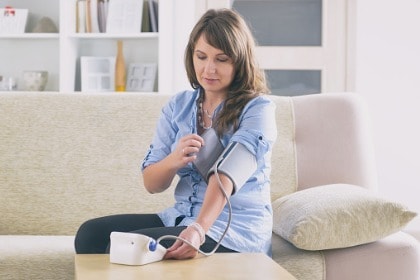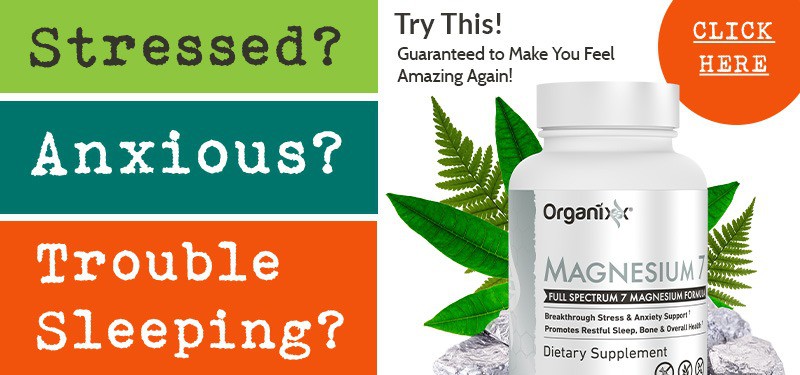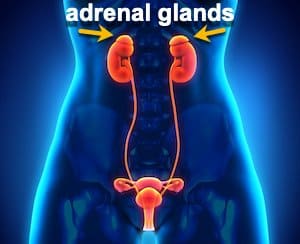The American Institute of Stress estimates that nearly 80% of people nowadays regularly suffer physical symptoms of stress, which includes issues such as anxiety, chronic fatigue, and poor sleep [1]. But it just so happens that these same symptoms are also associated with a much more serious stress-induced syndrome known as adrenal fatigue that, if left to run its course, can be downright life-debilitating.
What Are the Adrenal Glands?

The adrenal glands are small glands (about the size of a large grape) that sit on top of your kidneys. They’re responsible for the production of many important hormones, one of the best-known being cortisol – oftentimes referred to as the “stress hormone.”
(As a side note, in women approaching menopause, the adrenal glands also take over production of sex hormones as the ovaries start slowing down.)
The adrenal glands are designed to function as a natural buffer for periodic stress, routinely adjusting hormone levels to maintain homeostasis (a state of balance) throughout the body.
What Is Adrenal Gland Fatigue?
The term “adrenal fatigue” is a bit misleading in that it doesn’t refer to the adrenal glands themselves wearing out. Rather, it’s a breakdown in how the adrenal glands communicate with the brain through a connection known as the hypothalamic-pituitary-adrenal (HPA) axis.
When the body is under prolonged or severe stress it can lead to a communication breakdown in the HPA axis leading to either adrenal overactivity or underactivity [2].
Is Adrenal Fatigue Real?

It’s also worth pointing out adrenal fatigue is somewhat controversial and is much more recognized in the alternative health realm than it is in allopathic (Western) medicine. As a result, official statistics on its prevalence remain somewhat elusive.
However, it’s well accepted in all types of medical practice that the heightening demands of modern-day life are causing average stress levels to go through the roof. This means it’s likely safe to surmise that adrenal fatigue is much more common than many people think – and you may even be suffering from it yourself.
But, how can you know for sure?
How to Test for Adrenal Fatigue: 6 At-Home Options
The good news is that there are a variety of simple but effective options for assessing your adrenal gland function from the comfort of your own home (though it’s always advisable to consult with a qualified physician or health practitioner if you think you’re currently suffering from a serious health condition).
The following six at-home health tests are useful tools for learning more about the health state of your body, specifically with regards to potential adrenal abnormalities.
#1 – Saliva Test
The so-called “gold standard” for testing adrenal function is to have your cortisol and DHEA (dehydroepiandrosterone) levels professionally evaluated using saliva samples that you collect throughout the course of an average day (usually at four separate intervals).

A qualified laboratory will be able to assess the varying levels of these two critical hormones in your body and determine whether your adrenal glands are functioning in a state of overactivity, under-activity, or balanced normalcy.
According to adrenal expert Dr. David Jockers, an Adrenal Saliva Test typically costs around $300 and is generally not covered by standard insurance policies. It’s still worth getting, though – just so long as the laboratory that interprets the results does so by evaluating all of the saliva samples in tandem with one another.
An accurate hormonal assessment simply can’t be done from one single saliva sample, as your collective hormonal rhythm is where the real answers are found concerning adrenal status.
Using a simple, at-home saliva testing kit like the one offered by ZRT Laboratory will allow you to collect saliva samples at your convenience and send them off to the company for a customized analysis.
What you’ll receive back from this type of adrenal fatigue test is a thorough analysis and hormonal “map” indicating the daily diurnal curve of your free cortisol levels relative to your DHEA levels. This can accurately indicate the functional status of your adrenal glands [3].
#2 – Blood Pressure
Since another primary function of the adrenal glands is to regulate blood pressure levels, testing your blood pressure levels at home can also help to give you an idea as to any potential adrenal abnormalities.

If your blood pressure levels are high, this could be a sign of adrenal hyperfunction or high stress hormones. Conversely, low blood pressure levels could indicate adrenal hypofunction, or a lack of stress hormones.
“A normal resting blood pressure should be in the range of 110-130 mm/Hg (millimeters of mercury) over 70-80 mm/Hg,” explains Dr. Jockers. “A resting blood pressure over 130/80 mm/Hg can be a sign of high adrenal output. A resting blood pressure under 110/70 mm/Hg may be a sign of low adrenal output.”
You can test your blood pressure levels at home using either a less-expensive aneroid monitor, which has a simple dial gauge that shows readings with a pointer; or a more-expensive digital monitor, which displays blood pressure levels on a digital display.
Johns Hopkins Medicine recommends avoiding coffee and cigarettes at least 30 minutes prior to taking your blood pressure for such purposes and urges at-home testers to use the bathroom first and remember to relax before performing this test [4].
#3 – Pupillary Constriction
Also known as an Iris Contraction Test, a Pupillary Constriction Test measures the contraction of the eyes’ irises in response to sudden exposure to bright light after a period of time in darkness.
First described by Dr. C.F. Arroyo back in 1924, a Pupillary Constriction Test assesses the functionality of the hypothalamic-pituitary-adrenal (HPA) axis, an interconnected system inside the body that manages stress levels via the adrenal glands.

You can perform this simple adrenal fatigue test at home by sitting in front of a mirror in a dimly lit room for a few minutes before suddenly shining a flashlight in your eyes at a roughly 45-degree angle. As you do this, your irises will naturally constrict and decrease in size. The time it takes for this to occur, as well as the process by which it occurs, can tell you a whole lot about your adrenal function.
If your irises stay constricted (small/closed) for 20 seconds or longer in response to the light, your HPA axis is likely functioning up to par. If your irises experience fasciculation (twitching) for roughly 10-20 seconds, you could have mild HPA axis disruption.
If this fasciculation lasts for just 5-10 seconds, then you might have generalized HPA axis fatigue. And if there’s an immediate pulsation and dilation of your irises (they get big and then small) in response to the light, then you could have more severe HPA axis exhaustion or failure.
#4 – Orthostatic Hypotension
Similar to the Blood Pressure Test we already covered in #2, an Orthostatic Hypotension Test involves just the use of a blood pressure cuff. After lying down and resting for five minutes, take your blood pressure and write down the results. Then stand up and immediately take your blood pressure again, also writing down the results.
According to Dr. Jockers, your systolic pressure (the top number) should naturally rise about 10 mm/Hg when you shift from the lying to the standing position. If your systolic pressure remains at the same level or decreases, this could be a sign that your adrenals are fatigued and failing to naturally release epinephrine when you stand, which they would normally do to ensure that enough blood is pumping towards your heart.
“Your doctor will diagnose orthostatic hypotension if you have a drop of 20 millimeters of mercury (mm Hg) in your systolic blood pressure or a drop of 10 mm Hg in your diastolic blood pressure within two to five minutes of standing up, or if standing causes signs and symptoms,” explains the Mayo Clinic, which also recommends this test [5].
#5 – Sargent’s White Line Test
First developed by French endocrinologist Emile Sargent, Sargent’s White Line Test is a simple way to test for moderate-to-severe adrenal hypofunction at home [6]. It’s said to be about 40% effective in revealing the presence of adrenal fatigue and can be done at no cost using a pointy, but not sharp, object such as the dull end of a retracted ballpoint pen.

To perform this test effectively, first uncover your abdomen and expose it to natural light for 15 minutes. Then, take your pointy object and gently and lightly stroke a patch of skin back and forth, creating a roughly six-inch straight line. Be sure not to scratch or break the skin in the process.
Within a few seconds, a white line should appear that, not long after that, turns red in color – this being an indicator that your adrenal glands are healthy.
If the line stays white for several minutes, however, widening but never turning red, this could suggest the presence of adrenal gland fatigue. That’s because a lack of reddening typically suggests insufficient blood pressure levels in the body, which as with the Blood Pressure Test points to adrenal output being too low.
#6 – Rogoff’s Sign
Named after Dr. Steven Rogoff, the physician who first discovered it, Rogoff’s Sign is another simple, at-home test for evaluating adrenal function.
It’s pretty self-explanatory: if you experience unrelenting pain in the midsection of your back where your ribs are located – and it never really goes away like muscle pain would – this could be a sign of underlying adrenal fatigue [7].
What to Do With Your At-Home Adrenal Test Results?
The purpose of doing an adrenal fatigue test at home is not to turn you into your own doctor, but to help you keep an eye on your own health status. Please discuss any worrisome or inconsistent findings with your primary healthcare provider to determine what actions, if any, are recommended.
Maintaining Healthy Adrenals Through Diet & Lifestyle
Keep in mind that your overall adrenal health is dependent upon you maintaining a proper electrolyte balance within your body – particularly a balanced ratio of sodium and potassium.
Trace minerals, full-spectrum sea and earth salts, and mineral-rich foods – not to mention plenty of clean water and rest – are all necessary for keeping your adrenal glands fully charged, adequately hydrated, and ready to go at all times.
Some additional health & lifestyle approaches that can help to keep your adrenals fit as a fiddle include:
- supplementing with vitamins and other minerals such as magnesium [8]
- maintaining an anti-inflammatory diet
- avoiding caffeine and sugar
- skipping foods that trigger gut problems and sensitivities
- exposing your skin to natural sunlight
- exercising regularly
- using essential oils
- turning off your phone and other electronic devices at least one hour before winding down and going to sleep at night
Magnesium deficiency is linked to stress, diabetes, heart disease, osteoporosis, chronic fatigue syndrome, depression, anxiety, trouble sleeping, sore muscles, migraines, and many more debilitating health conditions.
If your body needs magnesium, you want the most beneficial kind your body can actually absorb. Organixx Magnesium 7 gives you seven (7) of the very best, most bioavailable types of elemental magnesium available.

Menopause (the ceasing of menstruation and reproduction) is a normal change that a woman will go through on average between the ages of 50 and 55 – although it can happen much earlier. Understanding the changes that happen in the body is vital, as natural decline in hormone levels during menopause can significantly affect a woman’s health for years to come.
The menopause process is gradual and has a few stages along the way. It starts as perimenopause, during which time the ovaries begin to make less of the hormones estrogen and progesterone, which interferes with an egg being consistently released each month. (By the way, the term menopause actually refers to when a woman has been 12 consecutive months without a period or other signs of fertility. Postmenopause is the stage after menopause has occurred. However many people use the term “menopause” to describe the entire process.)
The decline of hormone production starts slow (typically around age 35) and speeds up through her 40s as a woman approaches actual menopause. At some point during this transition, the ovaries get smaller and stop producing estrogen and progesterone altogether. At this stage, the adrenals take over the job of producing the sex hormones and menopause symptoms often become more pronounced.
The Problem With Diminishing Progesterone
The adrenal glands are widely known for the production of the stress hormones cortisol and adrenaline. But what many people  don’t realize is that the adrenals also produce other hormones, including the sex hormones estrogen and progesterone.
don’t realize is that the adrenals also produce other hormones, including the sex hormones estrogen and progesterone.
The adrenal glands are part of your long-term, back-up hormonal replacement part system and are designed to release whatever female hormone you may need. However, if the adrenals are not functioning well, sufficient progesterone won’t be produced which can cause havoc in the body.
The main purpose of progesterone is to prepare the body for pregnancy and provide the necessary support to ensure the fetus is carried to term. However, that is not the only role that progesterone plays in a woman’s body.
Progesterone is responsible for many important tasks, such as:
- increasing libido
- protecting against fibrocystic breast disease
- maintaining the uterine lining
- hydrating and oxygenating the skin
- decreasing hair thinning
- acting as a natural diuretic
- helping protect against depression and increasing a sense of well-being
- encouraging fat burning and the use of stored energy
- improving clarity
- promoting good sleep
Other Hormones Also Need Progesterone
Progesterone is also the precursors for other important stress and sex hormones (which means it’s needed to make other hormones). While estrogen levels don’t fall until later in the menopause transition, progesterone levels decline sooner and more dramatically leading up to menopause.
Body signals that include symptoms such as hot flashes are most likely the result in a shift in the balance between estrogen and progesterone.

The Impact of Stress on Progesterone
Another risk to progesterone is that the body releases cortisol in response to physical and psychological stress.
When we experience periods of stress, our bodies excrete cortisol to help us work through whatever the situation may be. If there’s a high demand for cortisol due to prolonged stress and the body is unable to keep up with the supply, it will take from cortisol’s pre-hormone, pregnenolone (the mother hormone of all sex hormones).
When more of pregnenolone is used to make cortisol, less will be available to make progesterone, which will further exacerbate menopausal symptoms and affect overall well-being.
The short-term results of stress may not be noticeable, but in the long run chronic stress can lead to adrenal fatigue. This sets the stage for increased inflammation in the body and lowered immunity, which creates numerous disease states.
Are YOU Suffering From Adrenal Exhaustion?
If you have been under constant stress for a prolonged period of time, you may be at the point where your adrenals are fatigued and your hormones are significantly out of balance.
Noticeable symptoms, such as weight gain, irritability, racing thoughts, chronic fatigue, and sleep disturbance are common in people who have adrenal fatigue. When adrenal fatigue is the primary cause of your low progesterone level, you need to focus on rebuilding your adrenal foundation.
Do you find yourself constantly fatigued and struggling to get out of bed in the morning? Do you feel unable to cope with stressful situations? If so, you might be suffering from Adrenal Fatigue Syndrome.
Answer These 18 Yes or No Questions
The more “yes” answers you have to the following questions, the more likely you are to have exhausted your adrenals:
- Do you have difficulty getting up in the morning?
- Do you have continued fatigue or low energy?
- Are your thoughts less focused; do you have brain fog?
- Do you have difficulty falling asleep or staying asleep?
- Do you crave salty, fatty, or sweet foods?
- Do you have blood sugars issues (hyperglycemia or hypoglycemia)?
- Do you have an afternoon slump between the hours of 2 and 5 pm?
- Do you often have muscle aches or pains for no apparent reason?
- Do you have an increased sense of irritability?
- Do you feel overwhelmed by all that needs to be done?
- Have you noticed an increase in belly fat and an inability to get rid of it?
- Do you have a decreased sex drive?
- Do you have low blood pressure?
- Do you have a low body temperature or feel cold all of the time?
- Do you have an increase in mood swings and or depression? Lack of enthusiasm?
- Do you experience dizziness when getting up quickly from a lying or sitting position?
- Do you suffer from increased allergies even if you have never had allergies before? Do you have food allergies?
- Do you have increased menopausal symptoms?
If you suspect you have adrenal fatigue, here are 6 ways you can do an adrenal fatigue test at home (and also consult with your healthcare provider!)
How to Support Your Adrenal Glands
The adrenal glands, just like the other glands in your body, need quality food to do their job effectively. It’s important to consume a clean diet loaded with organic fruits and vegetables that is devoid of artificial sweeteners and processed foods.
a clean diet loaded with organic fruits and vegetables that is devoid of artificial sweeteners and processed foods.
Daily detoxification is also essential. Cruciferous vegetables such as kale, broccoli, and cauliflower help detoxify the body.
Milk thistle can be helpful as it helps to break down and eliminate excess hormones and toxins. Be sure to drink plenty of water from a pure source. Your liver has to process any unused chemicals – the more toxins you put in your body, the harder the organs of detoxification have to work.
Stress reduction is also important as research shows that stress and anger are significant factors in menopausal symptoms and contribute to adrenal fatigue. Many women find they have more hot flashes and other symptoms when the adrenal glands are overworked by stress.
Electric and magnetic fields (EMFs) emitted from electronic devices (including your cell phone!) stimulate the body’s stress system, decreasing the ability to wind down and fall asleep. Once you finally do fall asleep, EMFs interfere with the deep sleep your body needs. Poor sleep also causes the adrenals to pump more cortisol, which keeps you awake longer and causes you to wake up after you fall asleep.
The bottom line is that women are systemically being told that their hormone levels are “within range,” but this is far from the truth. Further investigation with a healthcare professional fluent in hormonal issues is often required.
Feeding the adrenals, reducing your toxic load, supporting the liver, and addressing adrenal fatigue can help balance the hormones, which can actually make women healthier, happier, and more balanced during all phases of the menopause process.
13 Tips for Reducing Adrenal Fatigue
- Get 7-8 hours sleep every night.
- Heal the gut with probiotics and bone broth.
- Optimize liver function and detoxification with milk thistle and cruciferous vegetables.
- Get enough B5, also known as pantothenic acid, as it helps provide the extra energy your adrenal glands need to respond to stress and helps repair previous damage to these glands.
- Herbs such as Holy basil help to inhibit the release of cortisol and balance blood sugar levels.
- Reishi mushroom can help resolve the hormonal imbalance.
- Ashwagandha helps alleviate brain fog and memory problems associated with chronic stress and bring a sense of calm to the body.
- Walk briskly or engage in another exercise 4-7 hours per week, with a balance of cardio and strength training. (Go here to discover more about the Best Exercises for Women Over 50)
- Give yourself “me time” for at least one hour a day, which can include stress-relieving activities such as QiGong and Yoga Nidra, or simply taking a walk in nature.
- Consume a healthy diet including adrenal-supportive omega 3-rich foods.
- Keep a gratitude journal.
- Limit cell phone and computer use in the evening hours.
- Enjoy life, laugh more, and find joy in every day.
While the cessation of the menstrual cycle may be an inevitable transition all women go through, supporting your adrenal glands as early as you can in the process will have a huge impact on how you look and feel through menopause and beyond.





